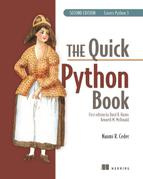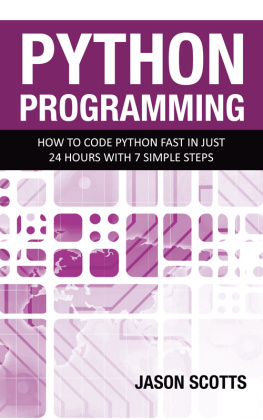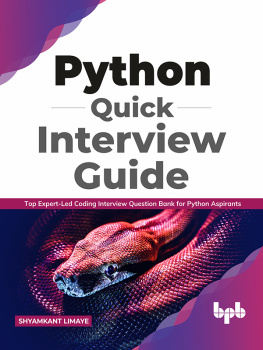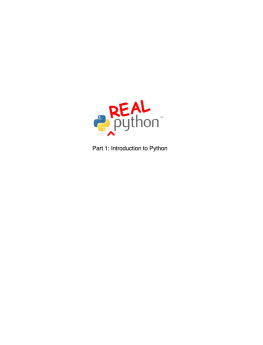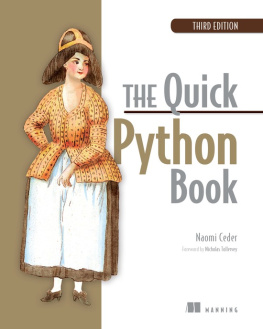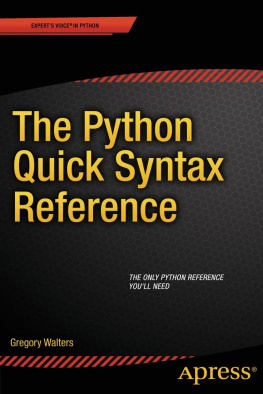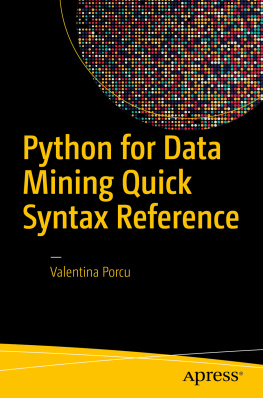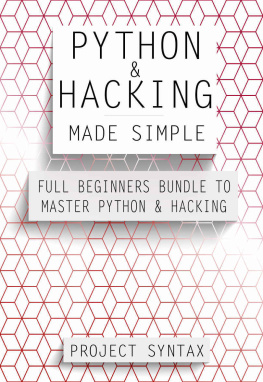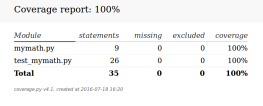Naomi R. Ceder - The Quick Python Book
Here you can read online Naomi R. Ceder - The Quick Python Book full text of the book (entire story) in english for free. Download pdf and epub, get meaning, cover and reviews about this ebook. year: 2018, publisher: Manning Publications, genre: Home and family. Description of the work, (preface) as well as reviews are available. Best literature library LitArk.com created for fans of good reading and offers a wide selection of genres:
Romance novel
Science fiction
Adventure
Detective
Science
History
Home and family
Prose
Art
Politics
Computer
Non-fiction
Religion
Business
Children
Humor
Choose a favorite category and find really read worthwhile books. Enjoy immersion in the world of imagination, feel the emotions of the characters or learn something new for yourself, make an fascinating discovery.
- Book:The Quick Python Book
- Author:
- Publisher:Manning Publications
- Genre:
- Year:2018
- Rating:3 / 5
- Favourites:Add to favourites
- Your mark:
- 60
- 1
- 2
- 3
- 4
- 5
The Quick Python Book: summary, description and annotation
We offer to read an annotation, description, summary or preface (depends on what the author of the book "The Quick Python Book" wrote himself). If you haven't found the necessary information about the book — write in the comments, we will try to find it.
The Quick Python Book — read online for free the complete book (whole text) full work
Below is the text of the book, divided by pages. System saving the place of the last page read, allows you to conveniently read the book "The Quick Python Book" online for free, without having to search again every time where you left off. Put a bookmark, and you can go to the page where you finished reading at any time.
Font size:
Interval:
Bookmark:

For online information and ordering of this and other Manning books, please visit www.manning.com. The publisher offers discounts on this book when ordered in quantity. For more information, please contact:
Special Sales DepartmentManning Publications Co.
Sound View Court 3B
Greenwich, CT 06830
Email: orders@manning.com
2010 by Manning Publications Co. All rights reserved.
No part of this publication may be reproduced, stored in a retrieval system, or transmitted, in any form or by means electronic, mechanical, photocopying, or otherwise, without prior written permission of the publisher.
Many of the designations used by manufacturers and sellers to distinguish their products are claimed as trademarks. Where those designations appear in the book, and Manning Publications was aware of a trademark claim, the designations have been printed in initial caps or all caps.
 Recognizing the importance of preserving what has been written, it is Mannings policy to have the books we publish printed on acid-free paper, and we exert our best efforts to that end. Recognizing also our responsibility to conserve the resources of our planet, Manning books are printed on paper that is at least 15% recycled and processed without elemental chlorine.
Recognizing the importance of preserving what has been written, it is Mannings policy to have the books we publish printed on acid-free paper, and we exert our best efforts to that end. Recognizing also our responsibility to conserve the resources of our planet, Manning books are printed on paper that is at least 15% recycled and processed without elemental chlorine.

Sound View Court 3B
Greenwich, CT 06830
| Development editor: Copyeditor: Typesetter: Cover designer: | Tara Walsh Linda Recktenwald Marija Tudor Leslie Haimes |
Printed in the United States of America
1 2 3 4 5 6 7 8 9 10 MAL 15 14 13 12 11 10 09
Ive been coding in Python for a number of years, longer than any other language Ive ever used. I use Python for system administration, for web applications, for database management, and sometimes just to help myself think clearly.
To be honest, Im sometimes a little surprised that Python has worn so well. Based on my earlier experience, I would have expected that by now some other language would have come along that was faster, cooler, sexier, whatever. Indeed, other languages have come along, but none that helped me do what I needed to do quite as effectively as Python. In fact, the more I use Python and the more I understand it, the more I feel the quality of my programming improve and mature.
This is a second edition, and my mantra in updating has been, If it aint broke, dont fix it. Much of the content has been freshened for Python 3 but is largely as written in the first edition. Of course, the world of Python has changed since Python 1.5, so in several places Ive had to make significant changes or add new material. On those occasions Ive done my best to make the new material compatible with the clear and low-key style of the original.
For me, the aim of this book is to share the positive experiences Ive gotten from coding in Python by introducing people to Python 3, the latest and, in my opinion, the best version of Python to date. May your journey be as satisfying as mine has been.
I want to thank David Fugate of LaunchBooks for getting me into this book in the first place and for all of the support and advice he has provided over the years. I cant imagine having a better agent and friend. I also need to thank Michael Stephens of Manning for pushing the idea of doing a second edition of this book and supporting me in my efforts to make it as good as the first. Also at Manning, many thanks to every person who worked on this project, with special thanks to Marjan Bace for his support, Tara Walsh for guidance in the development phases, Mary Piergies for getting the book (and me) through the production process, Linda Recktenwald for her patience in copy editing, and Tiffany Taylor for proofreading. I also owe a huge debt to Will Kahn-Greene for all of the astute advice he gave both as a technical reviewer and in doing the technical proofing. Thanks, Will, you saved me from myself more times than I can count. Likewise, hearty thanks to the many reviewers whose insights and feedback were of immense help: Nick Lo, Michele Galli, Andy Dingley, Mohamed Lamkadem, Robby OConnor, Amos Bannister, Joshua Miller, Christian Marquardt, Andrew Rhine, Anthony Briggs, Carlton Gibson, Craig Smith, Daniel McKinnon, David McWhirter, Edmon Begoli, Elliot Winard, Horaci Macias, Massimo Perga, Munch Paulson, Nathan R. Yergler, Rick Wagner, Sumit Pal, and Tyson S. Maxwell.
Because this is a second edition, I have to thank the authors of the first edition, Daryl Harms and Kenneth MacDonald, for two things: first, for writing a book so sound that it has remained in print well beyond the average lifespan of most tech books, and second, for being otherwise occupied, thereby giving me a chance to update it. I hope this version carries on the successful and long-lived tradition of the first.
Thanks to my canine associates, Molly, Riker, and Aeryn, who got fewer walks, training sessions, and games of ball than they should have but still curled up beside my chair and kept me company and helped me keep my sense of perspective as I worked. Youll get those walks now, guys, I promise.
Most important, thanks to my wife, Becky, who both encouraged me to take on this project and had to put up with the most in the course of its completionparticularly an often-grumpy and preoccupied spouse. I really couldnt have done it without you.
This book is intended for people who already have experience in one or more programming languages and want to learn the basics of Python 3 as quickly and directly as possible. Although some basic concepts are covered, theres no attempt to teach basic programming skills in this book, and the basic concepts of flow control, OOP, file access, exception handling, and the like are assumed. This book may also be of use to users of earlier versions of Python who want a concise reference for Python 3.
introduces Python and explains how to download and install it on your system. It also includes a very general survey of the language, which will be most useful for experienced programmers looking for a high-level view of Python.
is the heart of the book. It covers the ingredients necessary for obtaining a working knowledge of Python as a general-purpose programming language. The chapters are designed to allow readers who are beginning to learn Python to work their way through sequentially, picking up knowledge of the key points of the language. These chapters also contain some more advanced sections, allowing you to return to find in one place all the necessary information about a construct or topic.
introduces advanced language features of Python, elements of the language that arent essential to its use but that can certainly be a great help to a serious Python programmer.
describes more advanced or specialized topics that are beyond the strict syntax of the language. You may read these chapters or not, depending on your needs.
A suggested plan if youre new to Python is to start by reading .
Those familiar with Python should also start with of this book.
Its possible that some readers, although new to Python, will have enough experience with other programming languages to be able to pick up the bulk of what they need to get going from and the
Font size:
Interval:
Bookmark:
Similar books «The Quick Python Book»
Look at similar books to The Quick Python Book. We have selected literature similar in name and meaning in the hope of providing readers with more options to find new, interesting, not yet read works.
Discussion, reviews of the book The Quick Python Book and just readers' own opinions. Leave your comments, write what you think about the work, its meaning or the main characters. Specify what exactly you liked and what you didn't like, and why you think so.

